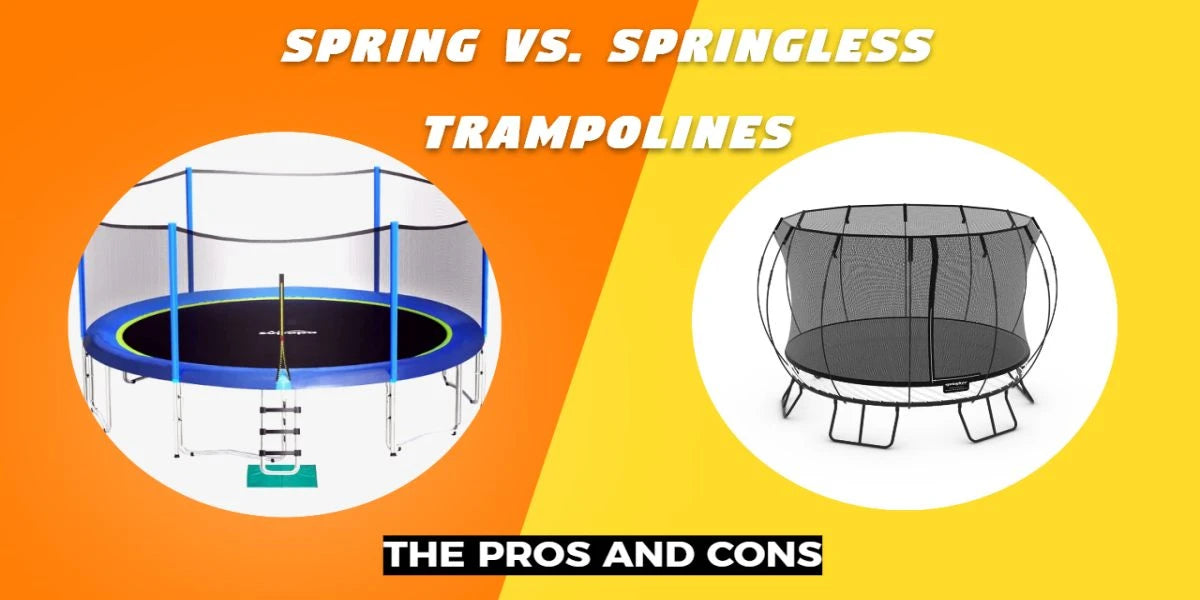Trampolines have been a recreational facility for many families to create wonderful memories. It has been one of the hot commodities for many years, and as time changes, trampolines are constantly being updated. Apart from adding accessories other than basketball frames or pipes, springless trampolines are gradually gaining a place in the market.
And when you want to choose a new backyard trampoline, you will be in a trampoline spring dilemma. Whether it's a spring or springless trampoline, there are pros and cons to both styles.
So, to be able to choose the best trampoline for you. We will break down the main differences between spring trampolines and springless trampolines so that you can decide which one is better for you.
Pros of spring trampolines
More elasticity
Springs absorb and return energy, allowing you to jump higher and save energy when jumping. The spring trampoline's responsive bounce allows for better control, making it ideal for experienced high jumpers and athletes looking to push their limits and show off their skills. This enables you to practice more trampoline skills. This is the kind of fun that is hard or impossible to get on a springless trampoline.

More durable
Certain opinions would argue that spring trampolines are not durable because the springs can be damaged. But springs can be easily replaced and the process of replacing or repairing other parts will not be difficult. The average lifespan of a spring trampoline is around 10 to 15 years.
Affordable
Let's use a 10ft trampoline as an example. A spring trampoline will cost between $300 and $500, while a spring-less trampoline will cost between $900 and $1,500. For families on a budget, spring trampolines are the most affordable option.
Variety
Spring trampolines come in a variety of sizes, including those for indoor and outdoor use. There are more recreational accessories available to make it more fun and can be tailored to meet your specific needs.
Cons of spring trampolines
Requires maintenance
One thing you can't avoid with an outdoor spring trampoline is rusty springs. Rusted springs will make the trampoline less flexible and cause more friction. So to keep the trampoline in service for a long time, the springs need to be inspected and cleaned regularly, and lubricants can be used if necessary.
Spring sound
In comparison, spring trampolines can be loud when bouncing. Especially if the springs are rusty, so some people may find it noisier than springless models.
Pros of springless trampoline
Avoiding safety hazards
Springless trampolines use reinforced mesh and frame material instead of springs. Since the trampoline has no springs, the risk of stepping into the spring gaps and getting scratched by them is avoided. It would be a good choice for even younger children.
Low maintenance
Since there is no spring, it does not require regular maintenance. Simply keep the trampoline clean and check the poles for cracks or flaking. If any are broken, contact the manufacturer of the trampoline.
More moderate
A springless trampoline will feel softer when bouncing because it doesn't change much based on the user's weight. It absorbs more of the impact when bouncing to the ground, making it easier for people with poor joints.

Cons of springless trampoline
Expensive
Most of the springless trampolines are made of flexible composite rods, which are more expensive, both in terms of the trampoline and the accessories. Especially if there are breakages that need to be repaired, it will be another extra cost.
Repairing is difficult
Unlike spring trampolines, prolonged exposure to sun/rain may cause premature deterioration of the seam tape that connects the mat sections. And while the springs are easy to replace, once the poles of a springless trampoline break, they will be very difficult to repair.
Differences between spring trampolines and springless trampolines
- Spring trampolines have a better bounce and will be more exciting and fun while bouncing. A springless trampoline, on the other hand, will be softer and less stressful on the joints.
- While a spring trampoline can be a potential safety hazard, a springless trampoline is safer and has no accessories that can cause injury.
- Rusty springs increase maintenance time, while springless trampolines need less maintenance. But repairs are more costly.
- Spring trampolines are usually half the price of springless trampolines. The price is more cost-effective both as a whole and in terms of accessories.
- The main material for the frame of the spring trampoline will be metal, while the springless style will be flexible composite poles. This is why springless models are more costly.
Conclusion
Overall, both trampoline types are good choices. If one prefers the exciting fun of bouncing or is not on a budget. Then a spring trampoline will add fun memories to your backyard.
If safety is a big concern for you, then a springless trampoline will be the choice without the risk of entrapment. Before deciding between spring or springless, weigh your priorities and needs carefully to get the best results.
Zupapa offers quality and multi-sized spring trampolines, plus up to a 10-year warranty, making it a brand you can trust. Now get out there and enjoy bouncing!





